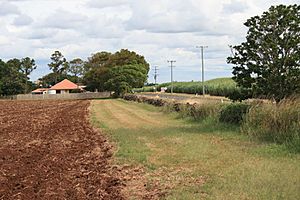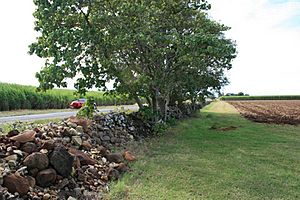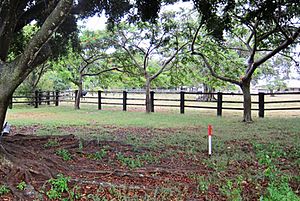Sunnyside Sugar Plantation facts for kids
Quick facts for kids Sunnyside Sugar Plantation |
|
|---|---|

Sunnyside Sugar Plantation, 2009
|
|
| Location | 94 Windermere Road, Windermere, Bundaberg Region, Queensland, Australia |
| Design period | 1870s - 1890s (late 19th century) |
| Built | c. 1880s |
| Official name: Sunnyside Sugar Plantation (former) Remains, Dry-rubble Boundary Wall, Sunnyside Sugar Plantation | |
| Type | state heritage (archaeological, built) |
| Designated | 13 May 1996 |
| Reference no. | 601700 |
| Significant period | 1880s (fabric) 1880s-1900s early (historical) |
| Builders | South Sea Islander labour |
| Lua error in Module:Location_map at line 420: attempt to index field 'wikibase' (a nil value). | |
Sunnyside Sugar Plantation is a historic site in Windermere, near Bundaberg, Queensland, Australia. It was once a large farm where sugar cane was grown. The plantation was built around the 1880s, and much of the hard work was done by South Sea Islander labourers. Today, what remains of Sunnyside, including an old stone wall and burial sites, is protected on the Queensland Heritage Register.
Contents
The History of Sunnyside Plantation
Sunnyside Sugar Plantation started as a 100-acre farm. Edward Turner set it up in 1875. By the early 1880s, it was growing sugar cane. South Sea Islanders worked here until the early 1900s.
In 1884, Turner built a "juice mill" on the property. This mill crushed the sugar cane and sent the juice through pipes to the Millaquin refinery nearby.
Today, you can still see some parts of the old plantation. These include two large weeping fig trees, a dry-rubble stone wall, and an area where 29 people were buried.
Bundaberg's Sugar Story
The sugar industry was very important to Bundaberg's growth from the 1880s. By 1900, Bundaberg became the biggest sugar-producing area in Queensland.
The use of South Sea Islanders as workers was always a debated topic. Many laws were made to try and protect them. Later, laws were passed to stop their employment and encourage white workers instead.
Bundaberg town was founded on the Burnett River in the late 1860s. Farmers came to grow sugar, taking advantage of new land laws. The first sugar mill in Bundaberg was built in 1872.
Edward Turner and Sunnyside
Edward Turner, who was a stonemason, bought 100 acres of land near Bundaberg in 1874. He named his farm "Sunnyside" and moved there in 1875.
By 1876, he had cleared and farmed 18 acres. He built a simple slab house and other farm buildings. He was growing maize at first. By 1880, he had 20 acres under cultivation, likely sugar cane.
South Sea Islander Workers
Like many farmers in the area, Edward Turner used South Sea Islander workers. These workers were first brought to Australia in the 1840s. In Queensland, they were brought to work on cotton and sugar plantations.
The idea at the time was that working in hot, tropical areas was unhealthy for Europeans. So, the Queensland Government allowed workers from Asia and the Pacific Islands to be brought in.
The first group of South Sea Islanders arrived in Brisbane in 1863. They worked on cotton and sugar farms. By 1868, over 2,100 Islanders had been brought to Queensland. They worked in many jobs, including farming and as servants. Their contracts usually lasted three years.
Laws to Protect Workers
Reports of workers being kidnapped (a practice called blackbirding) led to new laws. The Polynesian Labourers Act of 1868 was created to control how workers were recruited.
Under this law, Islanders had to sign a contract for up to three years. They were paid at least £6 per year, plus food and a trip home after three years. Deaths and workers leaving their jobs had to be reported. In 1870, government agents started sailing with recruiting ships to watch over the process.
More laws were introduced in the 1870s and 1880s to protect Islanders. The Pacific Islanders Labourers Act of 1880 set rules for their age, living conditions, medical care, and food. It also said Islanders could only work in tropical farming, like growing sugar cane.
The first direct shipment of Islanders to Bundaberg happened in 1879. These workers came from places like the Solomon Islands and New Hebrides (now Vanuatu). These islands are part of a region called Melanesia.
Building the Plantation
Edward Turner continued to develop Sunnyside. In 1883, he partnered with Frederic and Charles Buss to build a juice mill. This mill started working in 1884. It crushed cane and sent the juice to the Millaquin Refinery, about 3 miles away. Many other juice mills were built in the area around this time.
In 1888, Turner became the sole owner of the juice mill site. He also bought more land, expanding Sunnyside to 190 acres. This was a typical size for smaller, family-run sugar plantations in Bundaberg.
Daily Life and Work
Herbert Turner, Edward's eldest son, wrote about life on the plantation. He said a 150-acre farm with a juice mill needed about 45 Islander workers.
Owners had to provide each Islander with a new blanket, clothes, a hat, and tobacco. They were paid £20 to £25 every six months. Three meals were given daily, as required by government rules.
Islanders cleared the land, which involved cutting down trees, burning them, and removing large volcanic stones. These stones were used to build dry-rubble walls.
Edward Turner was a stonemason, so he likely guided the building of the wall at Sunnyside. This type of wall, made without mortar, was common in the area.
Islanders also planted cane by dropping plants into furrows made by a horse-drawn plough. During harvest, they cut and loaded cane onto horse-drawn carts.
Health and Challenges
Inspectors were appointed to check on the health and well-being of the Islanders. Despite these efforts, many Islanders died due to diseases like dysentery, measles, and typhoid. They often had less immunity to these illnesses than Europeans.
On Sunnyside, seven Islander deaths were reported between 1887 and 1889. The exact causes are unknown, and their burial locations are not recorded. It was common for Islanders to be buried on the plantations where they worked.
In 2012-2013, investigations found 29 possible graves on Sunnyside, near the two large fig trees.
The Turner family also faced tragedy. Edward's wife and two daughters died from typhoid in 1889-1890. It's possible some Islanders also died from typhoid at this time.
Changes in Laws and Labour
In the 1880s, new laws aimed to reduce the use of Islander labour. The Pacific Islanders Labourers Act of 1884 limited Islanders to field work. Another law in 1885 stopped new recruitment licenses after 1890.
The government also encouraged smaller, family-run farms and supported central sugar mills that used white labour.
By 1891, it was clear that stopping Islander labour would hurt the sugar industry. New laws in 1892 set out conditions for employing Islanders. These laws aimed to improve working conditions and reduce exploitation. Islanders also became better at negotiating for higher wages.
In 1893, seven Islanders from Sunnyside complained about not getting enough food. They even burned a hut and set fire to cane in protest. Edward Turner was fined for not providing enough food.
The 1893 banking crisis also affected Turner, as his bank closed temporarily. This might have contributed to the food shortage.
To improve health, an Islanders' hospital was built in Bundaberg in 1893. Christian groups also provided support and education to the Islanders.
The End of Islander Labour
After Australia became a federation in 1901, the White Australia Policy led to the end of Islander labour. New laws required an end to recruitment by 1904 and deportation of most Islanders by 1906. However, some Islanders were allowed to stay if they had arrived before 1879, married non-Islanders, had children in school, or owned land.
In 1906, a commission looked into sending Islanders home. Some wanted to stay in Queensland. Sunnyside's overseer said he had been using white labourers since 1902 and found them reliable.
The Sunnyside juice mill closed in 1911. Larger, central mills like Millaquin made smaller private mills unnecessary.
Later Ownership
Edward Turner died in 1910. Sunnyside was later owned by his son Herbert and son-in-law Henry Cattermull. In 1922, the plantation was transferred to Benjamin and Sydney Herbert Courtice.
The Courtice family still owns parts of the former Sunnyside plantation today. Members of the Courtice family became important figures in the sugar industry and in politics.
The two large fig trees on the property were likely planted around the time Islanders worked there. They may have marked the entrance to the original house, which is no longer there. These trees are not native to Bundaberg and were probably planted after 1897.
The Bundaberg and District South Sea Islanders Action Group was formed in the 1980s. This group works to raise awareness of the history of South Sea Islanders and their contribution to the sugar industry. They have a strong connection to the fig trees, burials, and dry-rubble wall at Sunnyside.
In 2013, the heritage listing for Sunnyside was expanded to include the fig trees and burial sites. This happened after a long campaign by the Action Group and the current owner, Brian Courtice. Ground-penetrating radar found 29 graves, which helped confirm the importance of the site.
What You Can See at Sunnyside Today
The former Sunnyside Sugar Plantation is now called Sunnyside. It covers about 40.4 hectares of farmland.
The Dry-Rubble Wall
A dry-rubble wall runs for about 201 meters along Windermere Road. It's built from local volcanic rocks, collected when the land was cleared for sugar cane in the 1880s.
The wall is made of larger rocks on the outside, with smaller rocks filling the gaps. No mortar was used to hold the stones together.
The Weeping Fig Trees
Two large weeping fig trees stand about 100 meters south of the road. They are about 22 meters apart and are around 17 meters tall.
These trees were planted in front of the original house, which was removed in 1957. They are important because they mark a significant part of the plantation's history.
The Burial Site
The site where 29 South Sea Islander labourers are believed to be buried is about 50 meters southeast of the fig trees. Investigations in 2012 found evidence of these burials in three rows.
This area is very important for understanding the lives and working conditions of the Islanders.
Why Sunnyside is a Heritage Site
The former Sunnyside Sugar Plantation was added to the Queensland Heritage Register in 1996. It's important for several reasons:
Showing Queensland's History
The dry-rubble wall and burial site show the huge contribution South Sea Islanders made to Queensland's sugar industry. They are proof of the hard manual labour involved in growing sugar cane. Without these workers, it would have been very difficult to clear the land and start sugar farming.
A Rare Example
The boundary wall, which is about 200 meters long, is one of the best-preserved examples of its kind in the Bundaberg area. Many such walls existed, but few remain as intact as this one.
Learning About the Past
The wall and burial site can help us learn more about the role of South Sea Islanders in Queensland's history. They can also provide information about their burial practices, working conditions, and health.
A Good Example of Construction
The dry-rubble wall is a good example of how things were built in the Bundaberg area in the late 1800s. It shows a common construction method from that time.
Important to the Community
The South Sea Islander community in Bundaberg feels a strong spiritual connection to this place. It helps them connect with their ancestors who lived and worked on Sunnyside plantation.
The wall, fig trees, and burial site represent a key period in Queensland's history. They can help tell the story of events that greatly affected the lives of South Sea Islander descendants.
Connected to Important People and Groups
Sunnyside is linked to the large South Sea Islander workforce who were employed in the Bundaberg area in the late 1800s and early 1900s. It reminds us of their exploitation and their vital role in the sugar industry.
Images for kids






